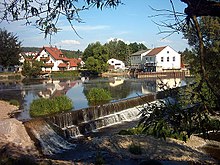Hammerwerk Schwarzenfeld
The Hammer Black box in the same place Schwarzenfeld was one of the oldest iron works in the Upper Palatinate . It is mentioned as early as 1326 and was located at the confluence of the Naab and Schwarzach rivers .
history
The first hammer owner known by name was Erhard Walzenhofer , who joined the Upper Palatinate hammer cleaning agency in 1387 . In 1419 a widow named Catharina Pachmann is mentioned here . Between 1425 and 1430 the work came to Georg Sauerzapf († 1437), who had married a daughter of Catharina Pachmann. He handed the hammer over to the existing hammer master Hans Sighart . The widow brought a lawsuit against him because he allegedly had not paid the hereditary interest to the Abbot of Plankstetten , which turned out to be untrue.
Erasmus Sauerzapf took over the feudal obligation for the widow and on his advice she left the hammer to his nephew Jakob Sauerzapf from Sulzbach in 1440/41 . After the widow had married the iron wholesaler Johann Plachmann from Amberg for a second time in 1441, massive arguments broke out between him and Jakob Sauerzapf. Plachmann was an important man who also owned the Blechhammer in Rohrbach and the Hammer in Dieltldorf . In 1456 he became mayor of Amberg († June 9, 1463). After his death, the hammer fell to his brother Niclas and after his death again to Plachmann's widow († 1493 or 1495). She was a contentious woman and has been involved in many legal processes. After her death, Hammer and Mühle came to their son Georg in 1495 . After him the work went to Fritz Zotzer and Wolf Deuchler bought it from him in 1511 , who then passed it on to Fritz Frankh von der Rornstadt († 1526) in 1512 . He was succeeded by his son Michael Frankh together with the brothers Wilhelm and Wolf , who both died soon. After his death in 1555, his widow Anna, geb. Lehenwager the Nabburg Paul Birkhner and he received the fiefdom in 1558. In the same year, however, she sold the hammer to Hans Graf, a citizen of Amberg . In 1564 Stephan Reininger bought it , who after a short time sold it to Hans Portner von Leidersdorf . In 1586 his son Endres Portner is named as the owner († 1594). Around 1603 his widow († March 28, 1617) married Sigmund von B (P) ertolzhofen († 1614), who was able to acquire the hammer on April 19, 1606 with the permission of the elector.
After the death of the Pertolzhofeners, the hammer came into the possession of the Palatinate councilor and rent master Abraham Schups († 1622) in 1615/16 . His heirs kept the hammer until 1629, but had to sell it to Conrad Teuffel because of the Counter Reformation . The hammer was totally destroyed in the Thirty Years War and was not rebuilt afterwards. In a report to Elector Ferdinand Maria by Johann Germann Barbing about the viable and impracticable rail, sheet metal and wire hammers in the Upper Palatinate , the hammer is described as totally rotten and lying desolate. The Hammergut itself was awarded to Colonel Peter von Pischern in 1662 . Since he only had two daughters, the next owner was Franz Christoph von Schneidau and in 1708 the property fell to his brother Heinrich Burkhardt Freiherr von Schneidau .
Hammer Schwarzenfeld today
Today there is still a weir at the site, the water of which is fed to a turbine system to generate electricity. The hammer building no longer exists; in its place is now an electrical plant.
literature
- Hans Nikol: The former Hammer Schwarzenfeld. In: Die Oberpfalz , 1973, Volume 61, pp. 268-271.
Coordinates: 49 ° 23 ′ 14.8 " N , 12 ° 8 ′ 31.3" E
